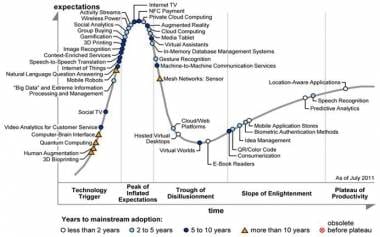

Second- and third-generation products appear from technology providers. More instances of how the technology can benefit the enterprise start to crystallize and become more widely understood. Investment continues only if the surviving providers improve their products to the satisfaction of early adopters. Producers of the technology shake out or fail. Interest wanes as experiments and implementations fail to deliver. Often no usable products exist and commercial viability is unproven.Įarly publicity produces a number of success stories-often accompanied by scores of failures. Early proof-of-concept stories and media interest trigger significant publicity. Posted by Rudy de Waele aka / shift2020.Each hype cycle drills down into the five key phases of a technology's life cycle.Ī potential technology breakthrough kicks things off. Gerd Leonhard on the unintended consequences of the IoT: proceed with cautionĪnd some related slides courtesy of Gerd Leonhard: IoT Shifts Conference, Barcelona, October 19-20 Why The Internet Of Things Will Drive A Knowledge Revolution Gartner’s 2015 Hype Cycle for Emerging Technologies Digitization blurs the lines between technology companies and other types of businesses makers of industrial machinery, for example, are creating new business models by using IoT links and data to offer their products as a service. As in other technology waves, both incumbents and new players have opportunities.

However, developing economies could generate nearly 40 percent of the IoT’s value, and nearly half in some settings. Still, we estimate that it will have a higher overall value impact in advanced economies because of the higher value per use. The IoT has a large potential in developing economies.Business-to-business applications will probably capture more value-nearly 70 percent of it-than consumer uses, although consumer applications, such as fitness monitors and self-driving cars, attract the most attention and can create significant value, too.That’s because this information is used mostly to detect and control anomalies-not for optimization and prediction, which provide the greatest value. For example, on an oil rig that has 30,000 sensors, only 1 percent of the data are examined. Currently, most IoT data are not used.Of the total potential economic value the IoT enables, interoperability is required for 40 percent on average and for nearly 60 percent in some settings. Interoperability between IoT systems is critical.Some of the other findings in the report, include: At the top end, that level of value-including the consumer surplus-would be equivalent to about 11 percent of the world economy.
Gartner hype cycle iot 2015 full#
The central finding in the report is that the hype may actually understate the full potential-but that capturing it will require an understanding of where real value can be created and a successful effort to address a set of systems issues, including interoperability.Īccording the report, the IoT has a total potential economic impact of $3.9 trillion to $11.1 trillion a year by 2025. Although The Internet of Things (#IoT) is still listed as one of the top hypes in Gartner’s 2015 Hype Cycle for Emerging Technologies this year, a new McKinsey Global Institute report, The Internet of Things: Mapping the value beyond the hype, attempts to determine exactly how IoT technology can create real economic value.


 0 kommentar(er)
0 kommentar(er)
